FAQ
KNOWING WHAT IT IS, IS KEY
From our daily experience, we have developed a FAQ manual for your permanent consultation. The manual is organized by topics and you will easily find the answers to many of your questions.
IF YOUR QUERIES ARE NOT COMPLETELY SATISFIED HERE, WE WANT TO RESOLVE THEM IN THE FIRST PERSON
At the bottom of all pages of the site, you can:
– Perform conversions of weights and measures
– Perform container filling calculation
– Calculate exact and updated amounts in all currencies.
FREQUENT QUESTIONS
AND THE BEST ANSWER
Incoterms are a set of international rules, governed by the International Chamber of Commerce, which determine the scope of the commercial clauses included in the international sales contract.
Incoterms also called price clauses, as each term determines the elements that compose them. Incoterm selection influences the cost of the contract.
The purpose of Incoterms is to provide a set of international rules for the interpretation of the terms used in international trade.
Incoterms determine:
- The scope of the price.
- When and where the transfer of risk on the merchandise from the seller to the buyer occurs.
- The delivering place of the market.
- Who hires and pays transportation
- Who hires and pays the insurance
- Documents processed each part and its cost.
INCOTERMS
CFR (Cost and Freight):
The seller pays for transportation and other things necessary for the goods to the named port, although the risk of loss or damage of the goods is transferred from seller to buyer once this has been delivered on board the ship at the port of embarkation and has pierced the side of it. Also, it requires the seller to clear the goods for export. Insurance is paid by the buyer.
CIF (Cost, Insurance and Freight):
The seller has the same obligations as under CFR, but also must hire and pay the marine insurance coverage premium for loss or damage to the goods during transport, also seized, the clearance of goods for export.
CIP (Carriage and Insurance Paid to):
This term requires the seller the same way as the CPT and must also insure and pay the premium to cover loss or damage to the goods during transport, although it is only required to purchase insurance with minimum coverage.
CPT (Carriage Paid To):
The seller pays the freight and transports the goods to the place of destination. The risk of loss or damage is transferred from seller to buyer when the goods have been delivered to the custody of the first carrier nominated by the seller, if there are several. The export customs clearance is done by the seller.
DAF (Delivered at Frontier – Delivered border):
The seller fulfills his obligation when, once dispatched the goods at customs for export delivery at the point and place of the border, before passing the customs border of the adjoining country without downloading responsibility. It is vital to precisely define the term “frontier”.
DDP (Delivered Duty Paid):
In this term the seller delivers the goods to the buyer, cleared for import and not unloaded from the means of transport to their arrival at the place agreed with the country of import. The seller bears all costs and risks, including duties, taxes and other charges for bringing the goods thereto, once cleared for import.
DDU (Delivered Duty Unpaid):
The seller delivers the goods to the buyer at the agreed place by the country of the buyer, not cleared for customs import and not unloaded from the means of transport on arrival to that place. The term DDU can be used in any means of transport. The seller must bear all costs and risks associated with bringing the goods to the place. The buyer must pay any additional costs and bear the risks in case it cannot clear the goods for import in due time.
DEQ (Delivered Ex Quay):
The seller fulfills his obligation to deliver when the goods are placed at disposal of the buyer on the quay and once unloaded at the port of destination. This term is required to perform the customs clearance of goods for import buyer. Only for use in shipping.
DES (Delivered Ex Ship):
The merchandise is set by the seller to the buyer on board the vessel at the port of destination, without dispatching in customs for import. The seller bears the costs and risks of transporting the goods to the port of destination, but not unloading. It is only used when the transport is by sea.
EXW (Ex Works – In Factory):
The seller agrees to make available to the buyer in the agreed establishment or place (e.g. factory, workshop, warehouse, etc.) not cleared for export nor carrying the load on the receiving vehicle, concluding their obligations.
FAS (Free Alongside Ship):
The delivery of goods is made when placed by the seller alongside the vessel at the port of shipment, are borne by the buyer, all costs and risks of loss or damage to the goods from that moment on. This incoterm requires the seller to clear the goods for export.
FCA (Free Carrier):
The seller delivers the goods and dispatches for export to the chosen carrier by the buyer at the place. The chosen place of delivery determines the obligations of loading and unloading the goods at that place: if delivery takes place at the premises of seller, it is responsible for loading; if delivery occurs elsewhere, the seller is not responsible for unloading.
FOB (Free on Board):
The seller is obligated to load the goods on board the vessel at the port of shipment specified in the sales contract. The buyer selects the ship and pays the ocean freight. The transfer of risks and costs occurs when the goods exceed the ship’s rail. The seller is responsible for export formalities.
Cost of international transportation of goods either by air or sea (Freight).
Fuel Adjustment Factor. Affects the calculation of freight.
CY: Container Yard. Reception and delivery of containers. In this area, the containers remain filled (waiting to be loaded on means of transport) or empty (waiting to be transferred to the CFS area for filling later).
CFS: Carrier facilities. Area for filling and emptying. Access this area to fill empty containers and to empty full containers.
FCL: Full container load. Full container with a single charger merchandise. Indicating the acronym FCL-FCL shipping documentation shows that the container is filled entirely in the warehouse of an exporter and empties entirely in the warehouse of an importer.
LCL: Less container load. Container with goods of various chargers (consolidated). Indicating the acronym LCL-LCL shipping documentation shows that the container is filled (with goods of several shippers) in the cargo terminal of the port-airport-Auto Terminal of origin and empties into the cargo terminal port -airport-Auto Terminal arrival.
Shipping / airline companies provide mostly 1-2 month of validity in their offerings and this could last longer depending on the volume and frequency of shipments; however there is a time of year when international trade is termed as high season (Peak Season), generated by the increase in demand caused by the holiday shopping that runs from June to November, so shipping / airline companies start to limit the validity of their bids, confirming the validity of their freight only for 15 days for application / implementation shipment within those dates.
Reception costs, drag and loading of goods from reception in the port until it is loaded on board.
Grouping of goods belonging to several consignees, reunited to be transported in similar containers, provided and covered by a single transport document. It is used when the load is not enough to fill a container and this is partially for a client.
All countries except Cuba and countries under war.
With all carriers: Hamburg Sud, Maersk, Happag Lloyd / CSAV, Evergreen, Seaboard, King Ocean, Cosco, MSC, NYK, ZIM, CCNI, APL, YML, China Shipping, K-Line, SNL, OOCL, we look for the best option for our customers based on the performance of the service, freight costs and / or customer preference.
An operator or sea carrier that provides ships (boats) to transport cargo of any consolidator or client generally within an established frequency and freight registered.
It is the name of the general or specific product mentioned in the document either air waybill (AWB) or sea Bill of Lading (BL). In the case of dangerous goods must indicate specific IMO and UN data.
Tax paid by the importer to introduce products in a market. See Customs Duties of the importing country.
It is the document presented by the importer (or his agent or freight forwarder) for the clearance of goods, in order to take care of them.
Easy and fast, sending a copy of the proforma invoice / purchase order or otherwise the number of the order for your provider to locate the goods which you are contacting, data of the contact person and the supplier to contact directly to start the corresponding coordination.
For each of the different shipments shipping instructions customer requested. These instructions are given by the regulations and country customs regulations. For example:
- Tax data of the importing company as that of the exporter (name, legal address, telephone and contact person and depending on the country the RFC / RIF / RNC / RUC or RUT, required
- Description of goods; the language depends on the origin and destination of the shipment
- Customs Agent or Notify: to whom notify the arrival of the cargo
- If it must be insured and charged to the international transport.
All this information is contained in the Bill of Lading or better known as B / L (Bill of Lading).
Term referring to transport a possible shipment. The ideal time to apply the reserve is at least one week and up two weeks in advance if high season, as they must provide the delivery of documents of cargo and the delivery of the cargo as cut off (cutting time) per the output of each vessel.
Main documents required for the shipment both air and sea are:
- commercial Invoice
- packing list
- Certificate of origin -if it is required,
- packaging Declaration – in case it is required-.
- And others, depending on the nature of the goods and country of origin / destination.
Through all digital channels: telephone, e-mail, video-conferencing across platforms, Client Area within website.
It is the announcement of its load output port of origin, this notification is sent within 2-3 days after confirming the departure of the vessel. The same day or a day after the shipping as soon as you have formally expressed the load at the customs office. All the shipping information, departure and arrival, vessel name and trip number, BL´s number, agent destination for the removal of documents and detailed local benefits. Plus, it is sent along with a copy of all shipping documents.
Dangerous goods or goods IMO (International Maritime Organization) are those which, by their properties and characteristics, pose a risk to the safety and health of people.
Dangerous goods are classified in 9 categories different per their characteristics and degree of danger. Note that the numerical order of the classes, is not related to the magnitude of risk, therefore, it could be equally or more dangerous goods class 1 (explosives) than one of Class 7 (radioactive), as its danger depends directly on technical and / or chemical factors.
For a container to transport goods IMO, these labels must carry on all four sides, which should indicate same class and IMO number, per following list:
Class 1 Explosives.
Within this classification, we can find many types of merchandise, per risk of mass explosion or fire causing projection. Examples of explosives include: bombs, rockets, detonators, fireworks, ammunition, flares, etc.
- Division 1.1. Hazardous objects of entire mass.
- Division 2. They represent projection hazard but no explosion of entire mass.
- Division 3. They represent a fire hazard and can produce effects of shock wave.
The label of these first 3 is represented by the symbol of a bomb exploding (in black on orange background) and a number 1 in the bottom corner.
- Division 1.4. These do not represent a significant risk.
- Division 1.5. Involving sensitive little risk of mass explosion.
- Division 1.6. They are extremely insensitive and pose no risk of explosion throughout the mass.

The labels must contain the number of the ‘division’ in black on orange background. Should also contain the number 1 in the bottom corner of the label.
Class 2. Gases.
There may be liquefied, compressed or refrigerated. Per its properties are classified as: asphyxiating, oxidizing, flammable or toxic.
Depending on your reactions 3 divisions
- 1 Division emerge. Flammable gases. They can be ignited by a heat source, such as propylene, ethane or butane. Your label must contain the symbol of a flame either black or white on red background and number 2 in the bottom corner.
- 2 Division. Nonflammable gases, nontoxic. Causing suffocation displace oxygen, such as helium or oxygen. Your label must contain the symbol of a gas bottle in black or white on green background and number 2 in the bottom corner.
- 3 Division. Toxic gases. Inhalation may cause acute effects or even death. They may be flammable, corrosive or oxidizing, such as chlorine. Its label contains a skull cross bones symbol in black. The background is white and is identified with the number 2 in the bottom corner.

Class 3 Flammable liquids.
This classification includes flammable liquids and insensitive explosive liquids. They can be: paint thinner, gasoline, paints, varnishes, etc. Its label contains the symbol of a flame in black or white on red background (like the label for gases 2.1). It is distinguished by the number 3 found in the bottom corner.

Class 4 Flammable solids.
Per its properties are divided into
- Division 4.1. Flammable solids, self-reactive or explosive desensitized. These can react spontaneously. Your label must contain the symbol of a flame in black on a white background with seven vertical red stripes and the number 4 in the bottom corner.
- Division 4.2. Spontaneously flammable substances. They may ignite spontaneously when heated, when in contact with air or while being transported. These include: coal, ferrous metal shavings, wet cotton, etc. Your label must contain the symbol of a flame in black on white background colored red on top and half in the bottom half, with the number 4 in the bottom corner.
- Division 4.3. Substances which in contact with water emit flammable gases. Among the most common materials within this classification are: sodium, potassium, carbide, etc. Your label must contain the symbol of a flame in black or white on a blue background and the number 4 in the bottom corner.

Class 5 Oxidizers and organic peroxides.
Per its properties are divided into
- Division 5.1. Liquids or solids that support combustion, can favor the development of fires. One example is ammonium nitrate. Their labels must include the symbol of a flame over a circle in black on a yellow background and the number 5.1 in the bottom corner.
- Division 5.2. Organic peroxides. They derived from hydrogen peroxide. These substances, which are extremely dangerous, can only be loaded into a loading unit in certain quantities. Your label must contain a flame symbol on white or black on a red background and yellow in the upper half in the bottom half, and the number 5.2 in the bottom corner.

Class 6 Toxic.
Per their properties are divided into
- Division 1. Toxic substances. They can cause death by inhalation, skin absorption or ingestion. An example of these is methanol or methylene chloride. Your tag must have the symbol of a skull cross bones in black on a white background (same as the label for toxic gases 2.3), it is distinguished by the number 6 in the bottom of the label.
- 2 Division. Infectious substances. Contain pathogens (microorganisms) that can cause disease. Some include: diagnostic samples, material for making vaccines, secretions, blood, excrement, laboratory cultures, etc. In the bottom half of the label could lead the legend: “Infectious Substances” or “in case of damage or leakage immediately notify health authorities”. The label must also include the symbol consisting of three crescents superimposed on a circle in black color on a white background, and the number 6 in the bottom corner.

Class 7 Radioactive Material.
They contain radionuclides, such as uranium, thorium pustanio. The labels for these substances will be applied per the following:
- Category I. For packages with a maximum radiation level at the surface of 0.5 millirem / h for containers that do not contain packages with higher categories. This label, besides being white with a black clover symbol, must necessarily go under the caption: “Radioactive” followed by a small red vertical bar; then the following: “Contents … amount … activity”, as well as a number 7 on the bottom corner.
- Category II. For packages with a radiation level in the largest area to 0.5 millirem / h, not exceeding 50 millirem / h. The transport index must not exceed 1.0, or contain where the transport index does not exceed 1.0 and contains no visible lumps of category III.
- Category For packages with a maximum surface radiation level at 200 millirem / h, or for containers whose transport index is less or equal to 1.0 and carrying bundles visible category III.
- The label must be both yellow with edge in the top half, and white on the bottom half. Its symbol should be a shamrock in black color, and should also include bound form, the legend: “Radioactive” followed by two or three small vertical bars (by category). Then the data must contain “Content and activity”, followed by a black border box with the phrase “transport index” of as well as a number 7 on the bottom corner of the label.
- Category Fissionable materials. Your label must be white with the legend (required): “FISSILE” in black color, at the top, and a lower part, a box that says “Critical Care Index” and the number 7.

Class 8. Corrosives.
These substances have destructive effect on contact, i.e., they damage the skin tissue. Some substances may be: sulfuric acid or sodium hypochlorite. Your label must have a symbol with two tubes pouring liquid on one hand and on a metal test. The upper background should be white and the lower bottom black with the number 8.

Class 9. Miscellaneous dangerous objects.
These pose a hazard type not covered above, as could be the case of dioxins, lithium batteries, dry ice, etc. Your label must be white with 7 black vertical stripes on the top half, and underlined number 9 in the bottom corner.

It is important to mention that all labels without exception, must be diamond shaped and have minimum dimensions of 100mm x 100 mm. Only if the size of the package requires so, the labels may be reduced, provided and visible.
list of dangerous goods you can find through the International Maritime Organization (IMO) and / or the International Air Transport Association (IATA), among others.
The IMO is the International Maritime Organization, organization that requires that the load be accompanied by a declaration of dangerous cargo (DGD) and is used in shipping to inform the shipping line that is carrying dangerous goods.
It is a four-digit number established by the committee of experts carrying dangerous cargo United Nations to identify dangerous cargo in the field of international transport. It identifies the class and its subdivisions.
It is a generic term that covers the sea, air, road or rail document of the respective conveyor or international freight. It´s a delivery and certification of transport contract and receipt of the goods to be delivered to consignee at the destination and can be subject to endorsement.
It is the official document of transport, used in maritime shipments, may be direct to the exporter or to final consignee (BL) consolidated among our agents International Logistic.
The Bill of Lading (BL) is used for ocean shipments and the Airway Bill (AWB) for air. It is the document that contains all the information of shipment and is issued by the carrier (shipping / freight or airline). Without this document the cargo on arrival will not release.
It is the material or container for temporarily wrapping or containing, during handling, transporting and storing. Example: boxes, pallet, sacks, etc.
It is considered one of the systems unitization load simpler and used today because it allows grouping packages of different weight, size and dimension in a homogeneous unit load, which results in reduced costs and risks associated logistics operation. Measurements: Universal = 1200 x 1000 mm = 1200 x 800 Euro pallet mm. Maximum height = approx. 1.70 m
The most widely used worldwide containers are 20 and 40 feet long, with an approximate internal volume of 32.6 m³ and 66.7 m³ respectively, the measures vary in length and height.
The maximum load may vary per the shipping and container type. The most internationally standardized 20foot containers have a maximum gross weight of about 30.48 tons (i.e., the load plus the tare or container weight) and 40 feet of some 32.5 tons
Although, as often transfers the land from container loading areas to port, we must adhere to the laws in each country on maximum truck weights. Or tare weight of the container can vary from 1.8 t to 4 t for 20 feet and 3.2 t to 4.8 t for 40 feet.
The main types of containers are:
- Dry Van: These are standard containers. Sealed and without refrigeration or ventilation. Available for any normal dry cargo. Examples: bags, pallets, boxes, drums, etc.

CONTAINER: 20 FEET
WEIGHT: 18-22 TON (approx.)
VOLUME: 33,30 M3 (approx.)
LENGTH 5,900mts x WIDTH INTERNAL DIMENSIONS 2,345mts x HIGH 2,400mts
CONTAINER 40 FEET
WEIGHT: 26-27 TON (approx.)
VOLUME: 67.70 M3 (approx.)
LENGTH 12,030mts x WIDTH INTERNAL DIMENSIONS 2,345mts x HIGH 2,400mts
High Cube: standard containers mainly 40 feet long; its main feature is its over high (9.6 feet). Especially for bulky loads. Example: snuff, coal.
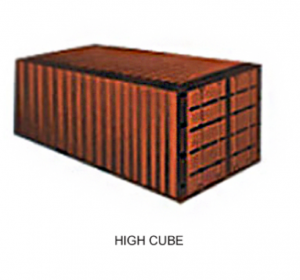
CONTAINER 40 FEET HIGH CUBE
WEIGHT 26.4 TON(approx.)
VOLUME: 76 M3 (approx.)
LENGTH 12,030mts x WIDTH INTERNAL DIMENSIONS 2,345mts x HIGH 2,710mts
Conair: No cold generator equipment. Preparations for cargo that requires constant temperatures. Example: apples, fruits, etc.
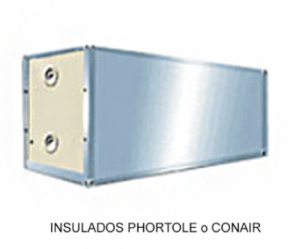
CONTAINER 20 FEET REFRIGERATED CONAIR
WEIGHT: 21-27 TON (approx.)
VOLUME: 27-29 M3 (approx.)
LENGTH 5,750mts x WIDTH INTERNAL DIMENSIONS 2,260mts x HIGH 2,250mts
Reefer: Refrigerated containers either 40 or 20 feet long, but they have a system for keeping cold or heat and thermostat. Must be connected to the ship and the terminal, even in the truck if possible or an external generator, powered by AC. With own cold generation equipment. Designed to carry cargo it requires constant temperatures below freezing. Example: meat, fish, fruits, etc.

CONTAINER 20 FEET REFRIGERATED
WEIGHT: 21-27 TON (approx.)
VOLUME: 28 M3 (approx.)
LENGTH 5,500mts x WIDTH INTERNAL DIMENSIONS 2,285mts x HIGH 2,255mts
CONTAINER 40 FEET REFRIGERATED
WEIGHT: 26-29 TON (approx.)
VOLUME: 58 M3 (approx.)
LENGTH 11,575mts x WIDTH INTERNAL DIMENSIONS 2,285mts x HIGH 2,250mts
CONTAINER 40 FEET HIGH CUBE REFRIGERATED
WEIGHT: 26-29 TON (approx.)
VOLUME: 68 M3 (approx.)
LENGTH 11,575mts x WIDTH INTERNAL DIMENSIONS 2,290mts x HIGH 2,250mts
Open Top: the same measures as above, but have removable canvas roof, specially designed for transporting heavy loads or extra dimensions. Allow loading and top discharge. Examples: heavy machinery, marble slabs, etc. You can excel the merchandise but, in that case, supplements are paid per how much load has stopped charging for the excess.
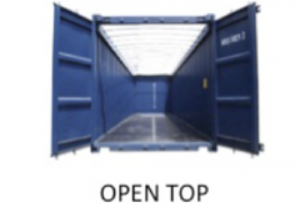
CONTAINER 20 FEET OPEN TOP
WEIGHT: 18-22 TON (approx.)
VOLUME: (approx.) 32.40 M3
INTERNAL DIMENSIONS: LENGTH 5,889mts x WIDTH 2,345mts x HIGH 2,346mts
CEILING OPENING: LENGHT: 5,492 x WIDTH: 2,184 METERS
CONTAINER: 40 FEET OPEN TOP
WEIGHT: 26-27 TON (approx.)
VOLUME: 65.70 M3 (approx.)
INTERNAL DIMENSIONS: LENGTH 12,024mts x WIDTH 2,345mts x HIGH 2,324mts
CEILING OPENING: LENGHT: 11,874 x WIDTH: 2,184 METERS
Flat Rack: Lack too sidewalls and even, per case’s, front and rear walls. They are used for atypical loads and pay supplements in the same way that the open top. Designed for transporting large cargo. Example: machinery, etc.
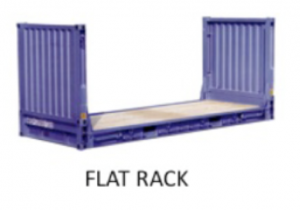
CONTAINER 20 FEET FLAT RACK
WEIGHT: 28 TON (approx.)
DIMENSIONS LENGTH 5,940 x WIDTH 2,345 x HIGH 2,346 meters
CONTAINER 40 FEET FLAT RACK
WEIGHT: 40 TON (approx.)
DIMENSIONS LENGTH 12,132 x WIDTH 2,400 x HIGH 2,135 meters
Open Side: its main feature is that it is open on one side, measuring 20 or 40 feet long. It is used for loads larger in length cannot be loaded by the container door.
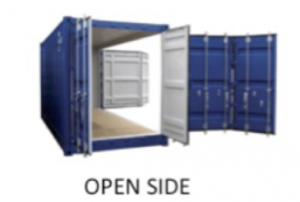
Flexi-Tank: For transport of bulk liquids. Provide an alternative to tanker container. A flexitank is a standard container (dry van), usually 20 feet long, inside which a flexible polyethylene tank called single use Flexibag is set.
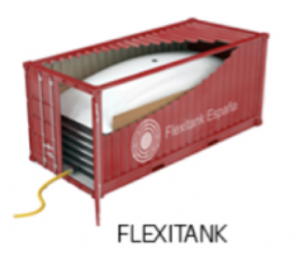
It is the announcement of arrival of the cargo at port of discharge, this notification is sent on the same day or the day after the shipping as soon as they have formally expressed the load at the customs office. Customer notification and / or your broker is issued, to inform, date of arrival, no registration, store name that receive the load, exact arrival date, name of the ship that arrived, amount of charge weight, quantity and type of containers.
Once the ship set sail, 2-3 working days the following documentation is sent via email
- Notification of shipment -in which all the shipping information, departure and arrival, destination agent for removal of documents is as follows: and local benefits.
- Bill of Lading – the set of 3 original and 2 copies will be delivered by the agent in destination.
- The free of charge arrival of the cargo as soon as the customer has made on paid expenses correspondingly at port premises
- insurance certificate -if acquire purchase policy.
- commercial invoices -copy, since the original should be sent by his supplier-.
- Packing list -copy, since the original should be sent by its supplier-.
- -a copy of the Certificate of Origin, since the original you must be sent by your supplier, this is also managed by the same supplier if it´s required-.
- -copy export declaration, if it is required-
- Declaration of -copy packaging, and this is provided by the supplier if is required-.
any other documents that apply depending on the type of product and importing country, as well as any other documentation that the supplier provide us.
At the time of the formal notification of the shipment is sent. Billing our services are carried out per previously agreed freight.
The load is insured if you decide so, and to do it you must notify your account. If the load is not insured and damage or loss occurs, we are not responsible for, as loads travel at risk of the importer or exporter as the term negotiation.
Document proving that insurance has been hired a cargo or shipment.
Issued document that identifies the goods and expressly declares where the merchandise was manufactured. Regularly, provided by the Chambers of Commerce as a request of the exporter/importer.

Recent Comments